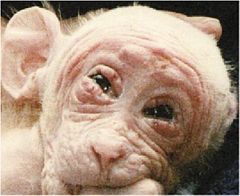 | |
| Date | April 20, 1985 |
|---|---|
| Location | University of California, Riverside |
| Participants | Animal Liberation Front (ALF) |
| Property damage | $700,000, according to the university |
In 1985, a raid took place at a laboratory belonging to the University of California, Riverside (UCR) that resulted in the removal of a monkey by the Animal Liberation Front (ALF). This monkey, called Britches (born March 1985), was a stump-tailed macaque who was born into a breeding colony at UCR. He was removed from his mother at birth, had his eyelids sewn shut, and had an electronic sonar device attached to his head—a Trisensor Aid, an experimental version of a blind travel aid, the Sonicguide—as part of a three-year sensory-deprivation study involving 24 infant monkeys.[1] The experiments were designed to study the behavioral and neural development of monkeys reared with a sensory substitution device.[2][3]
Acting on a tip-off from a student, the ALF removed Britches from the laboratory on April 20, 1985, when he was five weeks old.[4] The raid also saw the release of 467 mice, cats, opossums, pigeons, rabbits, and rats, and a reported $700,000-worth of damage to equipment.[5] A spokesman for the university said that allegations of animal mistreatment were absolutely false, and that the raid caused long-term damage to its research projects.[6]
The ALF handed the video of their raid over to People for the Ethical Treatment of Animals (PETA), which released it. The National Institutes of Health (NIH) conducted an eight-month investigation into the animal care program at the university and concluded it was an appropriate program, and that no corrective action was necessary.[7]
- ^ See Newkirk, Ingrid. Free the Animals, Lantern Books, 2000, pp. 271–294; "Abstract: Trisensor rearing with infant macaques" Archived 2008-12-06 at the Wayback Machine, Crisp; and Behav Neurosci. 1987 Oct;101(5):738-41.
- ^ Behav Neurosci. 1987 Oct;101(5):738-41: "The ability of neonate macaque monkeys to learn to respond to artificial spatial sensory information was studied through the use of compact, head-worn, electronic spatial sonars with audible displays, which translate spatial information into auditory dimensions specifying distance, direction, and surface characteristics. Three animals were born in the dark and raised without vision for 1 to 3 months while wearing either the Binaural Sensory Aid (Animal 1; Kay, 1974) or the Trisensor (Animals 2 and 3; Easton & Jackson, 1983) airborne sonars. Each animal demonstrated alertness to information transmitted by the devices in spontaneous reaching or reinforced discrimination tasks, and more device-related, perceptual-motor activities were observed when the sensors were switched on than when they were switched off. The results show that neonate monkeys can learn effective use of information obtained from sensory substitution devices through unstructured interaction with the environment.
- ^ Seeing with Sound
- ^ Cite error: The named reference
videowas invoked but never defined (see the help page). - ^ Franklin, Ben A. " Going to Extremes for 'Animal Rights'", The New York Times, August 30, 1987.
- ^ "Group Says It 'Rescued' 260 Animals From Lab," Associated Press, April 21, 1985.
- ^ Holden, Constance. "A pivotal year for lab animal welfare", Science 11 April 1986 232:249